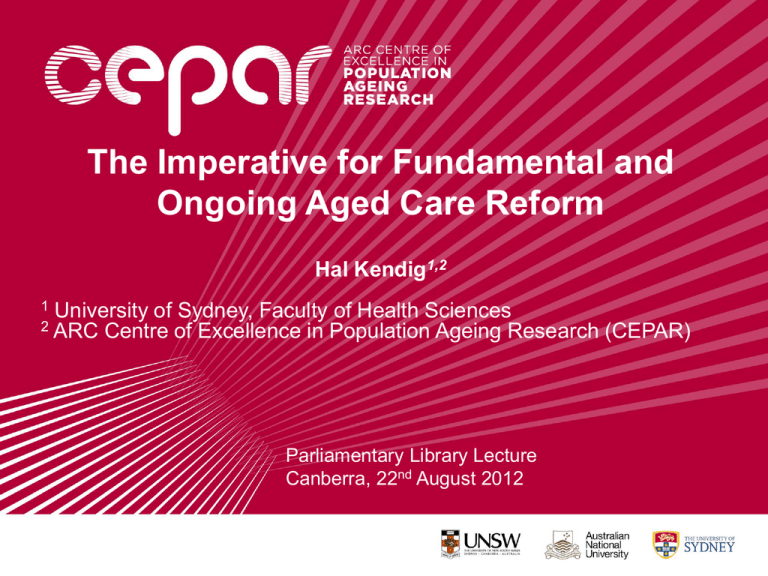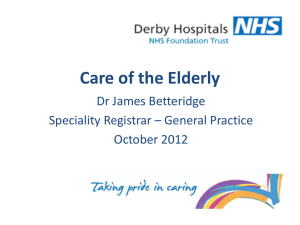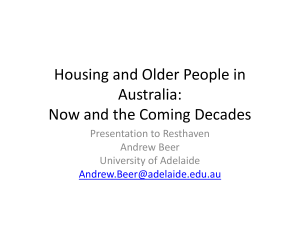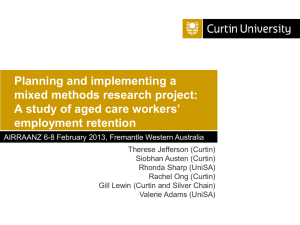Residential care
advertisement

The Imperative for Fundamental and Ongoing Aged Care Reform Hal Kendig1,2 1 2 University of Sydney, Faculty of Health Sciences ARC Centre of Excellence in Population Ageing Research (CEPAR) Parliamentary Library Lecture Canberra, 22nd August 2012 Overview 1. Main take-home messages 2. Introduction and Scene Setting 3. The Productivity Commission (PC) Report and Living Longer, Living Better (LLLB) Reforms 4. Taking Stock and Moving Ahead Note: For Government and Constituency positions please go their websites. My own views draw on research, observation, and peak body involvement since the 1980s. 1 1. Main take-home messages • Making the most of reforms requires an ongoing, bipartisan commitment (a main chance now) • Moving beyond controlling, centralised programs (valuable in their day) towards regional management of consumer directed care (essential for the future) • Economic restraint and unmet need will require more contributions from those who can afford it or rationing that will disadvantage those in most need • We can do it better, more efficiently through person centred and ‘whole of government’ approaches 2 2. Where we are now 3 2a. Legacies that built expectations and industries (‘drivers’, interests, & lessons) • Long term trend from providers, to funders, and now to ‘consumers’ (people!) • Long term trend from residential to community • Mid to Late 1980s: Aged Care Reform Strategy (after nursing home cost blow-outs & women’s movement) - Home and Community Care Program - Residential Care Program • Failed 1996 reforms (for capital contribution to nursing homes) and Hogan 2004 (recommended deregulation) • Productivity Commission 2012 (a new way ahead yet the same ongoing ‘structural’ issues). It will take time… 4 2b. Some Big-Picture Aims for Care Systems • Provide for changes (trajectories and transitions) and multiple needs (social, economic, care & health) • The importance of ‘upstream’ action (keep healthy) not only ‘downstream’ care, e.g. health promotion and maintaining and regaining independence • Client centred: consumer-led, continuity, improvability, integration, & timeliness – what service systems must and can deliver • Whole of government integration with mainstream health, housing, transport... At the community level 5 2c. Current Context • Strength of a community care system maturing over 25 years • Weaknesses of intergovernmental gridlock, centralised control, inflexible programs, and blame games) • Hard reforms have been postponed too long (and we have lessons from earlier efforts) • Opportunities with COAG reforms eg National Health and Hospital Reforms underway • Practitioners, older people, and carers can do it on the ground – IF supported by policies, structures, & funding 6 2d. What we have achieved (& not) • We have developed high expertise in quality aged care with some individualised and carer support • We are moving (against resistance) re-balancing from residential towards more community care • Increasing focus on needs, rights, and more support • But cost shifting remains with acute, residential, and community (and Commonwealth and State) • Integration and coordination have far to go • RESOURCES and workforce have far to go 7 2e. A new playing field? • Commonwealth responsibility for all HACC funding 2012 (except WA & Vic) as well as residential care • Commonwealth responsibility for more primary care (Medicare locals etc.) and national preventive health • Commonwealth-State joint funding of hospitals and State managed Local Health Networks Key Issues: Are we on the way to a single funder and hence ‘removing’ the blame game? Can the Commonwealth manage aged care? 8 2f Messages from Conversations with Mark Butler OLDER AUSTRALIANS: • Want quality services available when and where they need them • Prefer support to be provided at home, with people only wanting to contemplate residential care when there is no alternative • Would like a simplified and streamlined way to access information on healthy ageing, aged care services available and the quality of these services • Want to obtain their selected services in an equally seamless way • Have strong views about the need to have as much control as possible over their own death, as well as access to palliative care at home (where it is required) rather than having to go to hospital COTA (2012) Summary Report on the Conversations on Ageing, Adelaide. http://www.health.gov.au 9 3. The Productivity Commission ‘Caring for Older Australians’ • An historic opportunity to get it right for those who are old and their carers now and before major demographic and social change over the next decades • PC Recommendations as the basis for Government directions in the Living Longer, Living Better (LLLB) aged care reforms policies, and views on them • A valuable road map based on extensive consultation and (we hope) beginning a decade of purposeful reform 10 3a. Productivity Commission (PC) Reviewed the aged care system in 2010-11 Reported that: • • • • System was difficult to navigate Services and consumer choice were limited Quality was variable Coverage of needs, pricing, subsidies and user co-contributions were inconsistent or inequitable • Workforce shortages are exacerbated by low wages and some workers have insufficient skills. • Some regulatory aspects were excessive, unnecessary and/or duplicative After extensive review, consultation and submissions the PC concluded that the aged care system was in need of fundamental reform http://www.pc.gov.au/projects/inquiry/aged-care/report/key-points 11 3b. Living Longer Living Better Goals Prime Minister & Minister for Mental Health & Ageing Policy Launch 20 April 2012 • To make it easier for older Australians to stay in their homes while they receive care • To make sure more people get to keep their family home, and to prevent anyone being forced to sell their home in an emergency fire sale • To ensure there are immediate improvements as well… • Increase residential care places • Fund the Workforce compact • Establish a single Gateway to all aged care services • Set stricter standards with greater oversight To replace an aged care system designed a quarter of a century ago… ill equipped for retiring babyboomers and their parents who are living longer and healthier lives 12 3c. Australian Government Reforms April 2012 - Living Longer. Living Better (LLLB) (what government accepted from PC with budget) • The new reform package will be implemented in stages over the next 10 years, this will enable providers and consumers to gain early benefits of changes and have time to adapt (Gillard & Butler, 2012) • Most PC recommendations supported fully, partially or inprinciple; with consumer directed home care ‘packages’ • Response limited by fiscal pressure (2012-2013 budgets) • Aged Care Reform Implementation Council & Aged Care Financing Authority established (separate from Dept) 13 3d. Some PC Recommends & Govt Responses Productivity Commission: To deliver higher quality care with focus on the wellbeing of older Australians — promoting their independence, giving them choice and retaining their community engagement. [similar directions with some notable gaps] Older Australians would: • be able to contact a simplified ‘gateway’ for information, assessment and their financial capacity to contribute to the cost of their care My Aged Care website and national call centre will be established from 2013 (first step of Aged Care Gateway, online information and assessment) (Gillard & Butler, 2012) • Consumer Entitlement on the basis of assessment to approved aged care services; and for care coordination based on assessment [not accepted] Increased number (but not increased ratio) of Home Care Packages and residential aged care places (Gillard & Butler, 2012) • Contribute, in part, to their costs of care (with a maximum lifetime limit) and meet their accommodation and living expenses (with safety nets for those of limited means) The amount you pay for aged care services will be capped and underpinned by tightened means testing, nobody paying more than $25,000 a year and no more than $60,000 over a lifetime (Gillard & Butler, 2012) http://www.pc.gov.au/projects/inquiry/aged-care/report/key-points http://www.health.gov.au/internet/ministers/publishing.nsf/Content/mr-yr12-mb-mb032.htm 14 3d. PC Recommendations (continued) Older Australians would: •choose to pay either a periodic charge or a bond for residential care accommodation •if they wish to sell their home, retain their Age Pension by investing the sale proceeds in an Australian Age Pensioners Savings Account. Recommendation not accepted and family home not in means tests nor provision to pay for care costs from estates •have direct access to low intensity community support services •be able to choose whether to purchase additional services and higher quality accommodation •Limits on the number of residential places and care packages would be phased out, while distinctions between residential low and high care and between ordinary and extra service status would be removed – clients may still have to move between providers in the mean time to 2021 •Safety and quality standards would be retained. An Australian Aged Care Commission would be responsible for quality and accreditation; and would transparently recommend efficient prices to the Government http://www.pc.gov.au/projects/inquiry/aged-care/report/key-points http://www.health.gov.au/internet/ministers/publishing.nsf/Content/mr-yr12-mb-mb032.htm 15 3e. Additional Government Reforms • ‘Workforce Compact’ - to improve the aged care workforce [re-target conditional payments with EB agreements] • Tackling Dementia eg care supplements • Addressing Diversity including ATSI • Better Health Connections eg palliative care • Establish Aged Care Data Clearinghouse eg geographic and social inequities • Five year implementation review: 2016-17 16 3f. Headline Response by COTA – A system that supports people to age well • • • • • • • • Operate in a wellness framework Entitlement to adequate and personalised services that belongs to the person A Gateway where people can get information, be assessed and get help to find right services in one place Give carers better support (needs assessed, access to services to help continue caring) The system will be equitable and fair Good quality services with transparent systems and pricing Choice of how to pay for residential care accommodation, enabling people to keep their residence. Accommodation prices will reflect the cost of providing it and the market in which it is offered (not determined by the assets you have) Australian Nursing Federation: Huge issues facing the aged care workforce: low pay, and difficult conditions means high staff turnover and fewer younger people entering... Catholic Health Australia: A service providers view ... Do not ‘gift older Australians a second rate aged care system’. Solution is to legislate aged care entitlement instead of rationing National Aged Care Alliance (2012) National Press Club Address, The aged care time bomb is ticking 17 3g. Widespread Support from NACA and .. The National Aged Care Alliance represents 28 peak national organisations in aged care including consumer groups, providers, unions and professionals. - Unanimously supports for the NACA Blueprint for Aged Care Reform (based on Living Longer. Living Better) - Concerns for ‘financing and sequencing issues’ Recommends (further and as a priority): 1. Independent and comprehensive cost of care study 2. Bring forward to 2012-2013 the LLLB Review and ability to charge for additional hotel & lifestyle services. 3. 2013 remove the low care high care distinction, a year earlier introducing new accommodation payments www.naca.asn.au 18 3h Human rights are fundamental to aged care reform (a new player) ‘Outcomes and objectives are important, of course, but we want to make sure that the fundamental way in which people receiving care are treated is respectful of their human rights’ ‘… beds and packages and services and workforce … important… But underlying it all is everyone’s right to choice, dignity, privacy etc’ Susan Ryan, Age Discrimination Commissioner www.australianageingagenda.com.au/2012/08/09 Australian Human Rights Commission (2012) Human rights approach to ageing and health: Respect and choice 19 4a Taking Stock and Directions Perspective •Sidney Sax (from geriatrician to health planner to Malcolm Fraser policy advisor) ‘The narrow range of the politically feasible’, ‘A Strife of Interests’, and ‘A Good Old Age’. It will change when older people hold the money themselves • Difficulties in implementing structural reform along with funding changes and fiscal restraints to attain ‘the surplus’ • Concern for the fiscal outlook in terms of economic growth, tax revenue, competing social expenditure – beyond population ageing. • Risk of under-provision especially for economically deprived people notably those who are not home owners 20 4b. ‘Who it is for’ What Older People Want and Think (and boomers more so) • Striving to ‘be oneself’ and self determining • Fierce will for independence (not a burden) • Imperative for Ageing in Place • Goals: feel well, health as a resource, and quality of life • Professionals, the public, and the media are making older people ‘feel old’ (ageism) and powerless, eroding contributions, participation, and self care 21 4c. Highlight Care and Support Issues for Older People The vast majority will have several decades of healthy and independent living beyond their 60s possibly with a few years of dependence and never enter residential care Community care and support is proven to be what older people want and it is proven to work and has to be developed further Residential care while important for specific care needs (notably some cases of confusion and end of life) is an increasingly small care setting as a back-up to community care A good death after a good life Sustainability: Mechanisms to enable people who have the means to fund more of their care (& better care) including use of their estates. 22 4d. ‘Unbundle’ accommodation & care The Principle: to enable choice and equity: • Older people responsible for their own accommodation and living expenses with means tests (welfare principle) Needs based care with a private contribution (health principle) Fundamentally different from residential care ‘packages’ Mix & match would allow choice, innovation, & competition But at present if you can’t afford accommodation how can you have community care? And accommodation costs and subsidies are still different across accommodation settings of care. 23 4e. Doing Accommodation Better The accommodation base for care in the community (eg Home Care packages) remains basically unaddressed. Can we innovate and learn from new models (eg Apartments for Life) as well as improvements in public housing, retirement villages, and support for homeless people Livable Housing Australia, building codes, and home modification as part of age-friendly community support Housing is one of the major areas where appropriate mainstream provision is a cornerstone, eg, land use controls, public housing, and income support for those who do not own homes 24 4f. Doing Care Better (funding and program consolidation) • LLLB Reforms on the way but will take a long time.. • The cornerstone of the Home Support Program a single, integrated and flexible ‘system of care provision’ including carer support, community support, provision for diversity – with direct access. • Home Care Packages as the flexible and focused way ahead for people with higher and more complex needs. • The magnitude of the job ahead to build adequacy and flexibility at local level. • Opening up ‘approved providers’to family and others? They do most of the care and support (accountability) 25 4g. Enable Independence • Older People in the mainstream of health promotion and community supports eg transport (difficult but essential) • Health promotion and self care in aged care and primary care (including chronic disease) • Enable and regain independence in community care as well as rehabilitation (Active Service Model in Vic) • The Home Independence Program Gill Lewin in WA [Our research shows that choice and a control are valuable in themselves] 26 4h Learning from Consumer-Directed Care Trials •The value of a flexible budget to be used effectively with older people and carers •Can enable older people to manage more on their own eg (re-) learning and modest equipment investment to clean and cook (preferred to services) •Generates the ‘system intelligence’ on what to supply and how to deliver it. • Learning that much of the current provision is not the highest priority •What if the older people had the money themselves? •ACH Good Lives for Older People 27 4i Towards Regional Care and Support Systems (beyond central control allocations) The Aged Care Gateway Agency has the potential to evolve into a comprehensive care and support system development ad management.. Eventually! Make sure that the elements of supply, management, and operations form a coherent system in the local context. Ensure access to services, enhancing continuity, and enhancing consumer choice and local accountability Ensure strong connections with local health and community services • Must overcome the fragmentation and ignorance facing consumers and carers 28 4j Entitlements • Entitlements (versus ongoing rationing) • The clear value of a ‘right’ to care. And what if the assessed need is far beyond supply and resources? • Enable older people’s contributions alongside (or instead of) government support. • The cost-effectiveness of specifically providing what people want and need. • Need to build up the care supply, care expertise and sustainable funding as it is happening. 29 4h Intelligent decision-making to benefits for older people and carers • Policy consistency and implementation: Consultation, accountability, and Listening’ (starting yesterday and continuing for many years) • Value of knowledge (applied research and translation including the Parliamentary Library) • AND WHAT CAN AND WILL PARLIAMENTARIANS DO? (over to you) 30 And in the following pages • • • • Acknowledgements Some websites Further readings References to Evidence 31 Acknowledgements • The Australian Research Council that funds our Centre of Research Excellence in Population Ageing Research (CEPAR) • COTA Australia has led the consumer focus in aged care reforms notably Ian Yates and Pat Sparrow. • ACHA Group in Adelaide with Mike Rungie, Jeff Fiebig, and Jane Massared for advice on how to do it. • Barbara Squires and Kate Bridge for ongoing discussions and Karla Heese for assistance with these overheads • Colleagues in government and agencies (Rebecca de Boer for today) who are informing my thinking and building aged care. 32 Some additional websites http://theconversation.edu.au/moving-in-the-right-direction-for-better-aged-care-6582 http://theconversation.edu.au/what-the-caring-for-older-australians-report-means-for-thefuture-of-aged-care-2773 http://theconversation.edu.au/ask-the-elderly-what-they-need-not-the-care-industry-3380 www.humanrights.gov.au/age/ageing/ (on the aged care reforms August 12) http://www.australianageingagenda.com.au/2012/07/10/article/NSW-embraces-itsageing-population/JLNLCJOALO ABC Radio National interview Hal Kendig and Minister on Ageing 4 May 12 http://www.abc.net.au/worldtoday/content/2012/s3495521.htm?site=sydney 33 Some further reading • • • • • • • ACH Group (2011). Good Lives for Older people, Annual Report 2010/2011, Aged Care & Housing Group Inc. South Australia. Productivity Commission submissions on their website (including COTA, Carers, ACSA, and my own) http://www.pc.gov.au/projects/inquiry/aged-care/submissions COTA. (2011). Aged Care Reform, Policy Newsletter, No 7, August 2011. COTA, Australia. COTA. (2012). Aged Care Reform: A fundamental shift is happening in Aged Care Policy Alert, No 6, April 2012, COTA, Australia. [ESSENTIAL READING] Department of Health & Ageing (2012) Evaluation of the consumer-directed care initiative-Final Report, Department of Health & Ageing, Canberra, Australia. Kendig, H. (2011). ‘The aged care sector should throw its weight behind reform recommendations, says expert’, Croakey (the Crikey health blog) Kendig, H. (2011). ‘Research and Evaluation Priorities; report of the Productivity Commission on Caring for Older People’, Australasian Journal on Ageing,30 (2): 5456. 34 Some References to Evidence Gibson, D. M. & Academy of the Social Sciences in Australia. (2010). Beyond life expectancy. Canberra : Academy of the Social Sciences in Australia, http://www.assa.edu.au/publications/occasional_papers/2010_CS5.php Jorm, L., Walter, S. R., Lujic, S., Byles, J & Kendig, H. (2010). Home & community care services: a major opportunity for preventive health care, BMC Geriatrics, 10, 26. Kendig, H. (2010). The intergenerational report 2010: a double-edged sword, Australasian Journal on Ageing, 29 (4): 145-146. Kendig, H., Browning, C., Pedlow, R., Wells, Y., & Thomas, S. (2010). Health, social, and life style predictors of entry to residential aged care: An Australian longitudinal analysis, Age and Ageing, 39 (3): 342-9. Kendig, H. & Duckett, S. (2001). Australian directions in aged care: The generation of policies for generations of older people, Australian Health Policy Institute at the University of Sydney, Commissioned Paper Series 2001/5 (113 pp.). Lewin, G. & Vandermeulen, S. (2010). A non-randomised controlled trial of the Home Independence Program, an Australian restorative programme for older home care clients, Health and Social Care in the Community, 18(1): 91-96. 35






